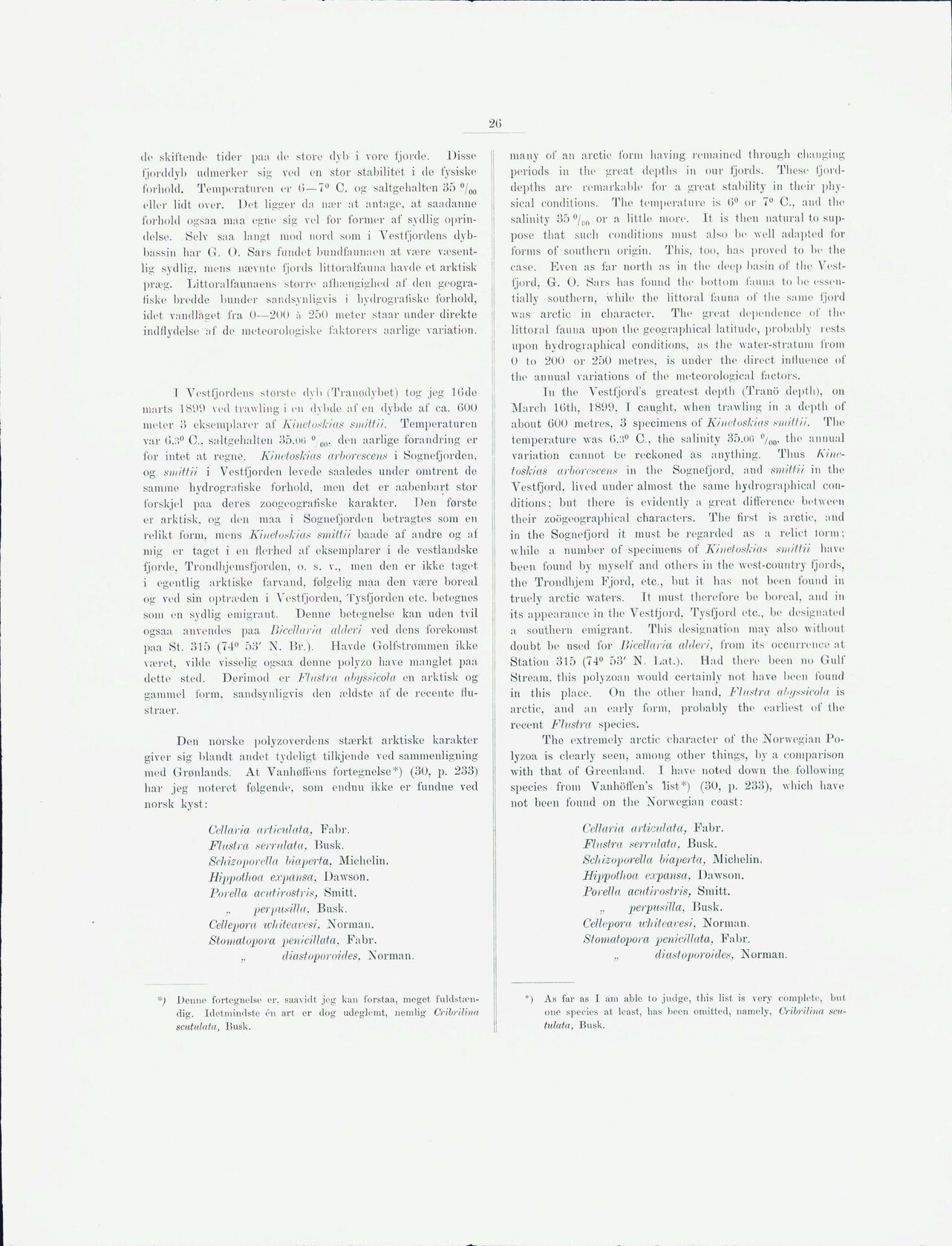
Full resolution (JPEG) - On this page / på denna sida - Sidor ...

<< prev. page << föreg. sida << >> nästa sida >> next page >>
Below is the raw OCR text
from the above scanned image.
Do you see an error? Proofread the page now!
Här nedan syns maskintolkade texten från faksimilbilden ovan.
Ser du något fel? Korrekturläs sidan nu!
This page has never been proofread. / Denna sida har aldrig korrekturlästs.
tie skiftende tider pan de store dyb i vore fjorde. Disse
fjorddyb udmerker sig ved en stor stabilitet i de fysiske
forhold. Temperaturen er ti—7° C. og saltgehalten 35 °/00
eller lidt over. Det ligger da nan- at antage, at saadanne
forhold ogsaa maa egne sig vel for former af sydlig
oprindelse. Selv saa langt mod nord som i Vestfjordens
dybbassin har (i. O. Sars fundet bundfaunaen at være
væsentlig sydlig, mens nævnte fjords littoralfauna havde et arktisk
præg. Littoralfaunaens større afhængighed af den
geografiske bredde bunder sandsynligvis i hydrografiske forhold,
idet vandlaget fra 0—200 ä 250 meter staar under direkte
indflydelse af de meteorologiske faktorers aarlige variation.
I Vestfjordens storste dyb (Tranødybet) tog jeg 16de
marts 1899 ved trawling i en dybde af en dybde af ca. 600
meter 3 eksemplarer af Kinetoskias smittii. Temperaturen
var 6.3° C., saltgehalten 35.06 0 co, den aarlige forandring er
for intet at regne. Kinetoskias arborescens i Sognefjorden,
og smittii i Vestfjorden levede saaledes under omtrent de
samme hydrografiske forhold, men det er aabenbart stor
forskjel paa deres zoogeografiske karakter. Den første
er arktisk, og den maa i Sognefjorden betragtes som en
relikt form, mens Kinetoskias smitt i i baade af andre og af
mig er taget i en flerhed af eksemplarer i de vestlandske
fjorde, Trondhjemsfjorden, o. s. v., men den er ikke taget
i egentlig arktiske farvand, følgelig maa den være boreal
og ved sin optneden i Vestfjorden, Tysfjorden etc. betegnes
som en sydlig emigrant. Denne betegnelse kan uden tvil
ogsaa anvendes pa a Bicellaria alderi ved dens forekomst
paa St. 315 (74u 53’ N. Br.). Havde Golfstrømmen ikke
været, vilde visselig ogsaa denne polyzo have manglet paa
dette sted. Derimod er Flustra abyssicola en arktisk og
gammel fonn, sandsynligvis den ældste af de recente
flu-straer.
Den norske polyzo verdens stærkt arktiske karakter
giver sig blandt andet tydeligt tilkjende ved sammenligning
med Grønlands. At Vaiihøfteiis fortegnelse*) (30, p. 233)
har jeg noteret følgende, som endnu ikke er fundne ved
norsk kyst:
Céllaria articulata, Fabr.
Flustra serrulatu, Busk.
ScMzoporeUa biaperta. Michelin.
Hippotlioa expansa, Dawson.
Forella acutirostris, Smitt.
,, perpusilla, Busk.
Cellepora wliiteavesi, Norman.
Stomatopora penicillata. Fabr.
diastoporoides, Norman.
many of an arctic form having remained through changing
periods in the great depths in our fjords. These
fjord-depths are remarkable for a great stability in their
physical conditions. The temperature is 6° or 7° C., and the
salinity 35 °/00 or a little more. It is then natural to
suppose that such conditions must also be well adapted for
forms of southern origin. This, too. has proved to be the
case. Even as far north as in the deep basin of the
Vest-fjord, G. O. Sars has found the bottom fauna to be
essentially southern, while the littoral fauna ol’ the same fjord
was arctic in character. The great dependence of the
littoral fauna upon the geographical latitude, probably rests
upon hydrographical conditions, as the water-stratum from
0 to 200 or 250 metres, is under the direct influence of
the annual variations of the meteorological factors.
In the Vestfjords greatest depth (Tranö depth), on
March 16th, 1899, 1 caught, when trawling in a depth of
about 600 metres, 3 specimens of Kinetoskias smittii. The
temperature was l>.:5° C., the salinity 35.06 °/00, the annual
variation cannot be reckoned as anything. Thus
Kinetoskias arborescens in the Sognefjord, and si nitt i i in the
Vestfjord, lived under almost the same hydrographical
conditions; but there is evidently a great difference between
their zoögeographical characters. The first is arctic, and
in the Sognefjord it must be regarded as a relict torm;
while a number of specimens of Kinetoskias smittii have
been found by myself and others in the west-country fjords,
the Trondhjem Fjord, etc., but it has not been found in
truely arctic waters. It must therefore be boreal, and in
its appearance in the Vestfjord, Tysfjord etc., be designated
a southern emigrant. This designation may also without
doubt be used for Bicellaria alderi, from its occurrence at
Station 315 (74° 53’ N. Lat.). Had there been no Gulf
Stream, this polyzoan would certainly not have been found
in this place. On the other hand, Flustra abyssicola is
arctic, and an early form, probably the earliest ol’ the
recent Flustra species.
The extremely arctic character of the Norwegian
Po-lyzoa is clearly seen, among other things, by a comparison
with that of Greenland. I have noted down the following
species from Vanhöffen’s list*) (30, p. 233), which have
not been found on the Norwegian coast:
Cell aria articulata, Fabr.
Flustra serrulata, Busk.
Schizoporella biaperta, Michelin.
Hippotlioa expansa. Dawson.
Porella acutirostris, Smitt.
„ perpusilla, Busk.
Cellepora rch it ear est, Norman.
Stomatopora penicillata, Fabr.
„ diastoporoides, Norman.
*) Denne fortegnelse or. saavidt jeg kan forstaa, meget
fuldstændig. Idetmindste én art er dog udeglemt, nemlig Cribrilina
scutulata, Busk.
*) As far as I am able to judge, this list is very complete, but,
one species at least, lias been omitted, namely, Cribrilina
scutulata, Busk.
<< prev. page << föreg. sida << >> nästa sida >> next page >>